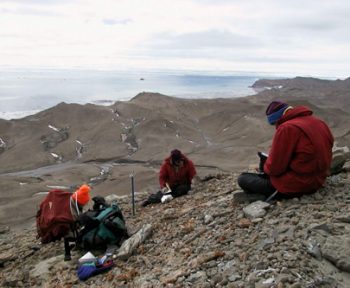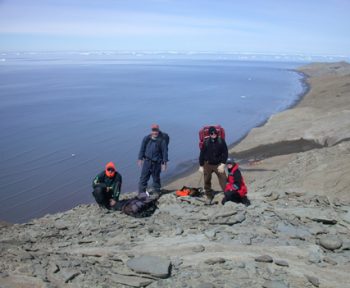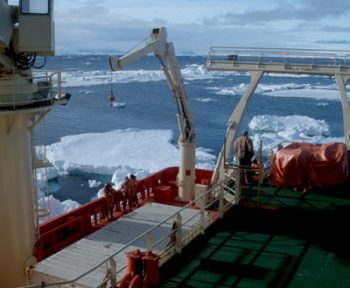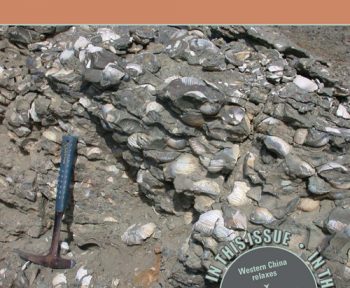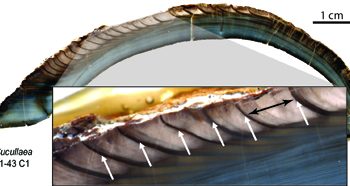Eocene Climatic and Biotic Evolution of Antarctica
The climate transition from the warm, equable world of the early Eocene to one in which continent-scale ice sheets blanketed the poles is reasonably well-known from sediments preserved at low and mid-latitudes, but little is known about the timing and magnitude of cooling on Antarctica, mostly because potential sedimentary archives are now covered by ice and inaccessible. One place on the continent contains a reasonably complete record of much of the Eocene in outcrop – the strata exposed on Seymour Island, off the coast of the Antarctic Peninsula. My colleagues and I collected fossil shells throughout the section to look at faunal change and used their stable isotope values to construct a record of climate through the Eocene. The data show that Antarctica experienced a shift toward cooler conditions ~41 million years ago, in concert with a proposed change in ocean circulation resulting from the opening of a marine gateway between Antarctica and South America. Cooling is associated with a notable change in the Antarctic biota, both on land and in the sea – a number of species become extinct and ecological changes suggest limitation by cold temperatures and/or low productivity.
Collaborators
- Rich Aronson (Florida Tech)
- Dan Blake (Illinois)
- Kacey Lohmann (Michigan)
- Hagit Affek, Peter Douglas (Yale)
- Tom Brey (Wegener Polar Institute)
- Matt Huber (Purdue)
- Eugene Domack (Hamilton)
- Peter Douglas (Caltech)
- Willem Sijp (New South Wales)
Student Research
- Nicole Miklus (M.Sc.) “The high-latitude response of temperature seasonality to global Eocene cooling”
- Devin Buick (B.S.) “100 years in the dark: extreme longevity of Eocene bivalves from Antarctica”
- Meghan Hazer (B.S.) “Color banding in Eocene naticid gastropods from Seymour Island, Antarctic Peninsula”
- Emily Judd (PhD Student)
Publications
(*student author)
Douglas, P.D., Affek, H.P., Ivany, L.C., Houben, A.J., Sijp, W.P., Sluijs, A., Schouten, S. Pagani, M. (2014) Pronounced zonal heterogeneity in Eocene southern high-latitude sea surface temperatures. Proceedings of the National Academy of Sciences USA, v. 111, p. 6582-6587.
Ivany, L.C., Brey, T., Huber, M., Buick, D.P., and Schöne, B.R. (2011) El Niño in the Eocene greenhouse recorded by fossil bivalves and wood from Antarctica. Geophysical Research Letters. v. 38, L16709, doi:10.1029/2011GL048635.
Aronson, R.B., Moody, R.M., Ivany, L.C., Blake, D.B., Werner, J.E., and Glass, A. (2009) Climate change and trophic response of the Antarctic bottom fauna. PLoS One, v. 4, e4385, doi: 10.1371/journal.pone.0004385.
Ivany, L.C., Lohmann, K.C, Blake, D.B., Hasiuk, F., Aronson, R.B., Glass, A., and Moody, R. (2008) Eocene climate record of a high southern latitude continental shelf: Seymour Island, Antarctica. GSA Bulletin, V. 120, no. 5/6, p. 659-678.
Ivany, L.C. 2007. Contributions to the Eocene climate record of the Antarctic Peninsula. in Antarctica: A Keystone in a Changing World – Online Proceedings of the 10th International Symposium on Antarctic Earth Sciences X, edited by A. K. Cooper and C. R. Raymond et al., USGS Open-File Report 2007-1047, Extended Abstract 068, p. 1-4.
Ivany, Linda C., Van Simaeys, Stefaan, Domack, Eugene W., Samson, Scott D. (2006) Evidence for an earliest Oligocene ice sheet on the Antarctic Peninsula. Geology, v. 34, p. 377-380.
Buick, Devin P.* and Ivany, Linda C. (2004) 100 years in the dark: extreme longevity of Eocene bivalves from Antarctica. Geology, v. 32, pp. 921-924.
Ivany, Linda C., Nesbitt, Elizabeth A., and Prothero, Donald R. (2003) The marine Eocene-Oligocene transition: a synthesis. In Prothero, D.R., Ivany, L.C., and Nesbitt, E.A. (eds) From Greenhouse to Icehouse: The Marine Eocene-Oligocene Transition. New York: Columbia University Press, pp. 522-534.
Prothero, Donald, Ivany, L.C., and Nesbitt, Elizabeth (Editors) (2003) From Greenhouse to Icehouse: The Marine Eocene-Oligocene Transition. New York: Columbia University Press, 541 p.

